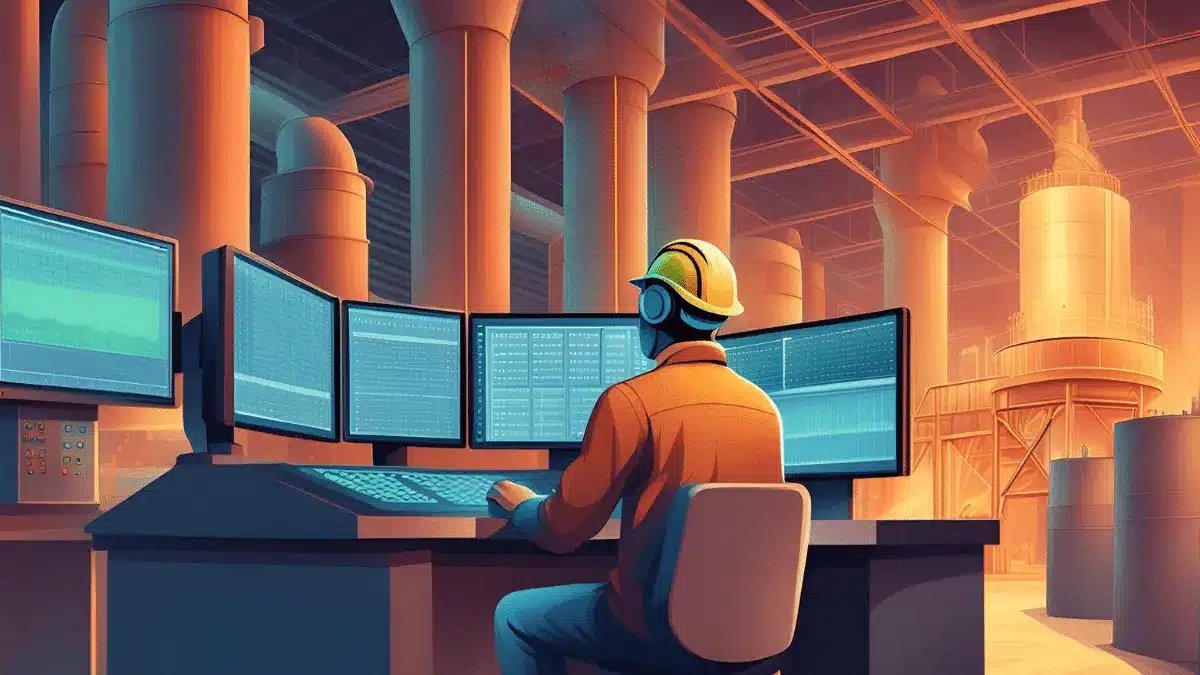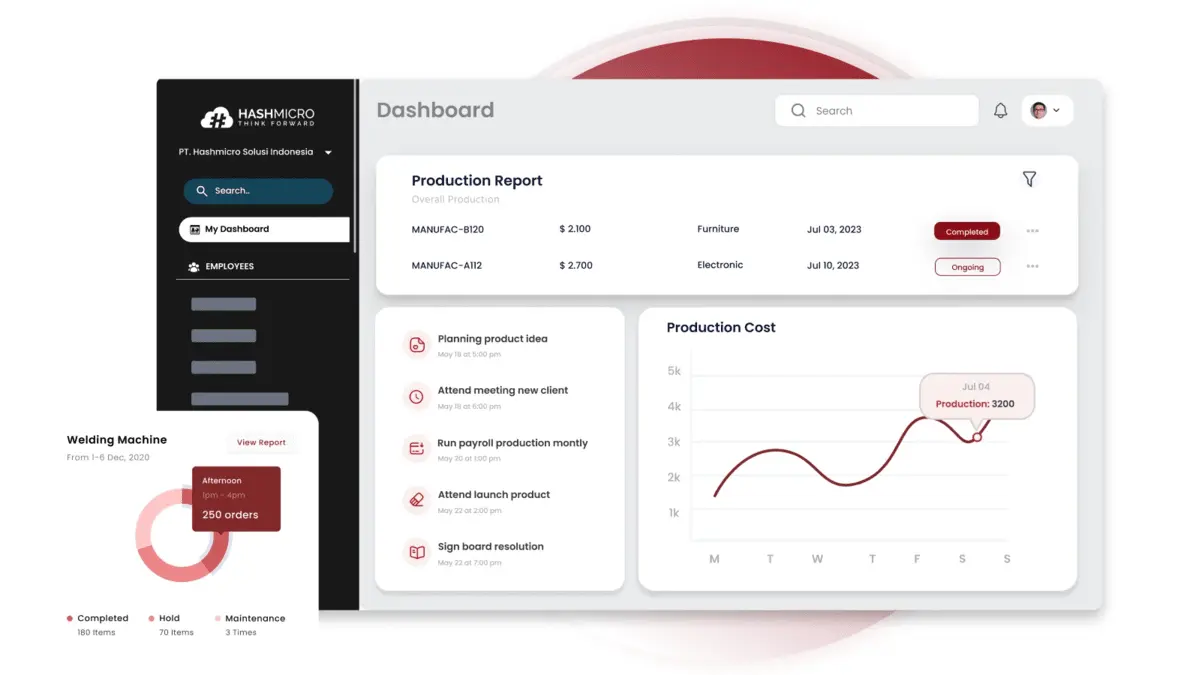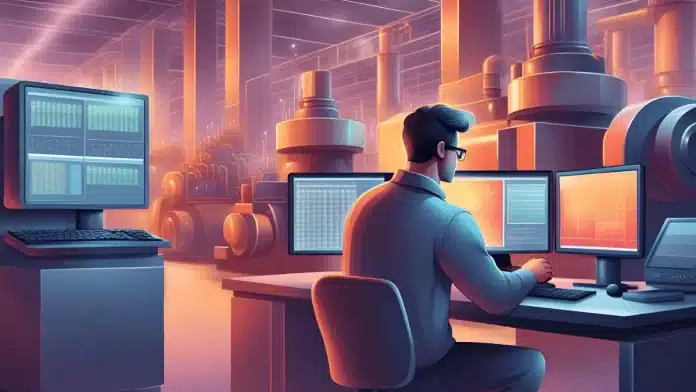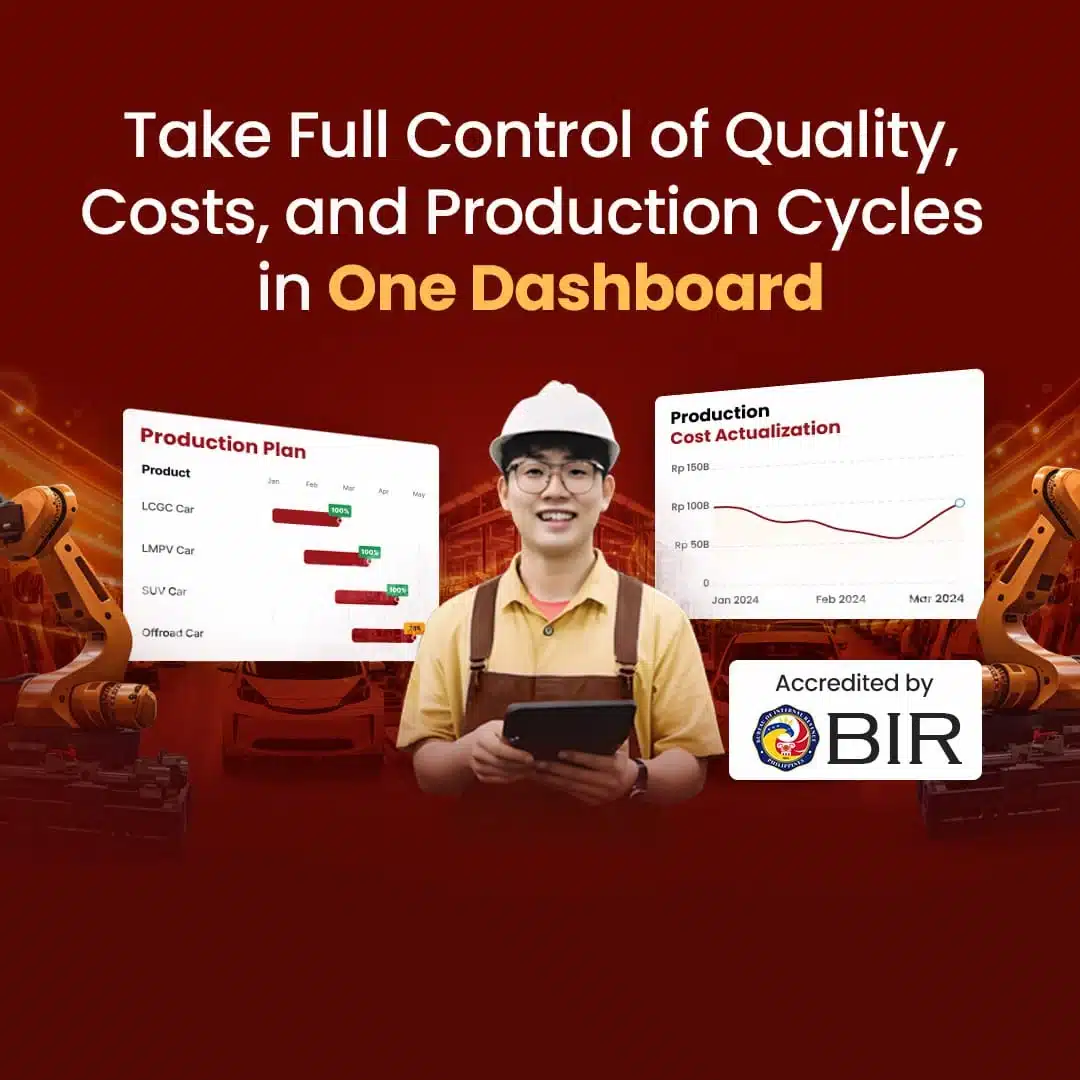Manufacturing Resource Planning (MRP II) is an advanced system that helps businesses manage more than just materials. It builds on early MRP systems by adding data on employees and finances for better overall planning.
The urgency felt by manufacturing companies in the Philippines to adopt advanced planning systems like Manufacturing Resource Planning (MRP) II has never been higher. The Philippine Statistics Authority noted a 15% reduction in inventory costs for companies implementing advanced planning tools.
Despite its importance, there’s often confusion about what MRP II offers and how it differs from ERP systems. This confusion can lead to businesses missing out on the critical advantages that these systems provide.
This article serves as a comprehensive guide to Manufacturing Resource Planning, particularly MRP II. We will explain why MRP is essential for manufacturing companies, clarify the differences between MRP I and MRP II, and compare MRP I, MRP II, and ERP systems.
Understanding the key functionalities and benefits of MRP II is crucial for manufacturers looking to optimize their operations and improve their bottom line. By the end of this guide, you will have a clear understanding of how MRP II can transform your manufacturing processes and help you stay ahead in a competitive industry.
Table of Contents

Key Takeaways
|
What are MRP I and MRP II?
MRP I, meaning Material Requirement Planning, is a system used by companies to manage their manufacturing processes. It helps businesses plan and control their production, ensuring that materials and resources are available when needed.
Companies that mass produce goods need a reliable system to keep production on track. By using MRP systems, they can plan each step in detail, ensuring materials arrive just in time. This approach prevents delays and allows factories to mass produce efficiently and at lower costs.
Meanwhile, MRP II, meaning Manufacturing Resource Planning is a system used by factories to manage and plan their production processes more efficiently. It builds upon the original MRP software, which focused mainly on materials needed for production.
MRP I works by looking at the company’s production schedule and inventory levels to determine what materials are required and when they should be ordered. This system helps avoid delays and shortages, making the manufacturing process more efficient.
It also helps reduce costs by ensuring that the right amount of materials is ordered, preventing excess inventory.
On the other hand, MRP II includes additional functions like scheduling, inventory management, and financial planning. This system helps companies ensure they have the right materials at the right time while also managing their workforce and equipment efficiently.
It combines data from different areas such as sales, production, and finance, providing a complete picture of the manufacturing process.
Why is Manufacturing Resource Planning II Important?

For enterprises in the Philippines, Manufacturing Resource Planning II (MRP II) software is crucial. Here are several reasons why it is important for companies to implement MRP II:
Enhanced production efficiency
MRP II systems is a part of manufacture ERP that streamline production schedules, reduce lead times, and optimize resource allocation. This leads to significant improvements in production efficiency and cost savings.
A study by the Asian Development Bank highlights that Filipino manufacturing firms adopting advanced planning systems reported a 20% increase in operational efficiency in the past two years.
Accurate demand forecasting
MRP II provides robust forecasting tools, helping businesses anticipate market demand accurately. According to the Philippine Statistics Authority, companies that utilized sophisticated demand forecasting tools saw a 15% reduction in inventory costs, minimizing stockouts and overstock situations.
Improved financial management
By integrating all aspects of the manufacturing process, MRP II offers real-time financial insights, aiding in better decision-making and financial control.
Studies have proved that businesses employing MRP II systems had a 10% improvement in financial management, contributing to higher profitability.
Regulatory compliance
MRP II helps businesses adhere to local and international regulations by maintaining accurate records and ensuring traceability. Compliance with regulatory standards is streamlined through the use of advanced planning systems, reducing the risk of non-compliance penalties.
Incorporating MRP II into manufacturing operations not only boosts productivity and financial performance but also ensures businesses remain competitive and compliant in the dynamic market environment of the Philippines.
You may check our article about the best manufacturing software to find the most suitable system solutions for your manufacturing business.
What are the key differences between MRP I and MRP II?
MRP I (Material Requirements Planning) and MRP II (Manufacturing Resource Planning) are systems used in manufacturing to manage materials and resources. Here are 5 key differences between them:
1. Scope of planning
MRP I (Material Requirements Planning) software focuses primarily on managing materials required for production. It helps companies determine what materials are needed, in what quantities, and when they are required.
On the other hand, MRP II (Manufacturing Resource Planning) software extends beyond materials to include other resources such as labor, equipment, and financials. This means MRP II provides a more comprehensive view of the entire manufacturing process.
2. Integration with other systems
MRP I is often a standalone system specifically designed for inventory management and production planning. It does not usually integrate with other business systems.
MRP II, however, is designed to be part of an integrated system that connects with other functions like finance, human resources, and sales. This integration allows for better coordination and planning across different departments.
3. Production scheduling
In MRP I, the focus is on scheduling materials to ensure they are available when needed for production. It calculates the material needs based on the production schedule but does not consider capacity constraints.
MRP II includes capacity planning, which takes into account the limitations of production resources such as machines and labor. This ensures that the production schedule is realistic and achievable.
4. Feedback and control
MRP I system provides basic planning without much feedback or control mechanisms. If there are changes in demand or production issues, adjustments must be made manually. MRP II incorporates feedback loops, allowing for continuous monitoring and adjustments.
This means it can automatically update plans based on real-time data, making the system more responsive to changes.
5. Financial integration
While MRP I focuses solely on materials and production schedules, the MRP II system includes financial planning and cost control. MRP II works like manufacturing accounting software.
This integration helps companies manage budgets, track costs, and analyze financial performance related to production activities. With the support of AI in manufacturing, it provides a more holistic approach to managing and optimizing manufacturing operations.
Understanding these differences helps manufacturers choose the right system to improve their production processes and overall efficiency.
MRP I vs MRP II vs ERP
Material Requirements Planning (MRP I), Manufacturing Resource Planning (MRP II), and Enterprise Resource Planning (ERP) are systems used to manage and plan company resources. Here is a comparison of these systems:
MRP I (Material Requirements Planning):
- Focus: MRP I focuses on materials needed for production. It calculates the quantity of raw materials required and when they are needed.
- Functions: It includes inventory control, bill of materials processing, and basic scheduling.
- Benefits: Helps prevent material shortages and ensures materials are available for production.
MRP II (Manufacturing Resource Planning):
- Focus: MRP II expands on MRP I by including additional resources such as labor and equipment.
- Functions: Along with inventory control and scheduling, MRP II includes production planning, capacity planning, and workforce scheduling.
- Benefits: Provides a more comprehensive view of the manufacturing process, improving efficiency and reducing costs.
ERP (Enterprise Resource Planning):
- Focus: ERP is an integrated system that covers all aspects of a business, not just manufacturing.
- Functions: ERP includes modules for finance, human resources, sales, supply chain, and more. It integrates all business processes into one system.
- Benefits: Offers real-time data access, improves decision-making, and enhances collaboration across departments.
Comparison:
- Scope: MRP I is narrow, focusing on materials. MRP II is broader, including additional resources. ERP is the most comprehensive, covering all business areas.
- Integration: ERP offers the highest level of integration, providing a single source of truth for all business operations.
- Complexity: ERP is the most complex and can be customized to fit the specific needs of a business, while MRP I and II are more focused on manufacturing processes.
In summary, MRP I and II are crucial for manufacturing management, while ERP systems offer a holistic approach to managing all business processes.
HashMicro is recognized as one of the top ERP system providers in the Philippines. They also offer powerful ERP for manufacturing solutions that help businesses manage their operations smoothly and efficiently.
For prospective clients interested in HashMicro’s products, the company provides detailed information about their pricing scheme. By offering clear pricing, HashMicro ensures that potential clients can evaluate the best options for their needs without any surprises.
HashMicro is The All-in-One Solution for Your Manufacturing Operations

HashMicro’s manufacturing software is a one-stop and advanced solution for MRP II for the manufacturing industries in the Philippines. Known for its comprehensive and innovative ERP solutions, HashMicro helps businesses streamline their operations and improve efficiency.
This vendor provides free demo access for their prospective clients with no upfront commitment. This allows businesses to experience the full range of features and benefits without any financial risk.
HashMicro manufacturing enterprise resource planning solutions cater to manufacturing companies’ needs by offering a suite of powerful tools designed to optimize every aspect of the production process. From resource planning to quality control, HashMicro’s ERP ensures seamless integration and superior performance.
Here are several key features of HashMicro’s manufacturing software:
- Kiosk mode: Simplifies employee clock-in/out and task management, increasing productivity and reducing manual errors.
- Manufacturing production scheduling: Helps plan and allocate resources efficiently, ensuring timely production and delivery.
- Manufacturing requisition planning: Streamlines the requisition process, ensuring materials are available when needed to avoid production delays.
- Made-to-order completion forecast: Provides accurate forecasts for made-to-order products, helping manage customer expectations and production schedules.
- Manufacturing subcon management: Facilitates effective management of subcontractors, ensuring all parts of the manufacturing process are coordinated smoothly.
- Manufacturing quality control: Ensures products meet quality standards through rigorous testing and inspection procedures.
- Finished goods production simulation: Allows for simulation of production processes to predict outcomes and optimize workflows.
- Manufacturing Gantt chart schedule management: Provides a visual representation of the production schedule, making it easy to track progress and make adjustments as needed.
HashMicro’s ERP solutions for manufacturing are designed to meet the unique needs of manufacturing businesses, offering a comprehensive and integrated approach to managing operations. With HashMicro, you can enhance productivity, ensure quality, and streamline your entire manufacturing process.
Conclusion
Manufacturing Resource Planning (MRP) systems, especially MRP II, play a crucial role in optimizing manufacturing operations. While MRP I focuses mainly on materials management, MRP II offers a broader scope by including other critical business aspects.
Compared to ERP systems, which provide a more comprehensive approach to managing various business functions, MRP II is specifically tailored for manufacturing needs.
For manufacturing companies in the Philippines, adopting MRP II can significantly improve operational efficiency, reduce costs, and enhance production planning. It helps streamline processes, manage resources effectively, and maintain high-quality standards.
HashMicro’s manufacturing software is an all-in-one solution designed to address the unique challenges faced by manufacturing businesses. With its advanced features and integration capabilities, HashMicro can help you optimize your manufacturing processes and achieve better results.
To experience the benefits firsthand, take advantage of HashMicro’s free demo offer now. This no-commitment trial allows you to explore how HashMicro’s ERP can transform your manufacturing operations. Try the demo today and see how HashMicro can drive your business forward!
FAQ about Manufacturing Resource Planning (MRP)
-
How does MRP II improve production efficiency for manufacturers?
MRP II improves production efficiency by automating the planning and scheduling processes. This system considers resource availability, lead times, and customer orders to create realistic production plans, reducing downtime and manual errors.
It provides a centralized platform for managing all production-related activities, ensuring timely procurement of materials and optimal resource utilization, which leads to faster production cycles and better quality control.
-
What industries benefit most from using MRP II systems?
Industries with complex manufacturing processes, such as automotive, electronics, and pharmaceuticals, benefit significantly from MRP II systems. These systems help manage extensive assembly lines and intricate production schedules, ensuring timely delivery and adherence to quality standards.
Small to medium-sized enterprises (SMEs) involved in multi-part product manufacturing can also improve their output and reduce costs by integrating MRP II into their operations.
-
How does MRP II contribute to better customer satisfaction and service?
MRP II contributes to better customer satisfaction by ensuring timely and accurate order fulfilment. It improves production planning and inventory management, which reduces the likelihood of stockouts or delays.
By maintaining high-quality standards and minimizing production errors, MRP II helps manufacturers deliver products that meet customer expectations, thereby enhancing overall customer service and satisfaction
-
What are the key features to look for in a manufacturing ERP system in the Philippines?
Key features to look for in a manufacturing ERP system include:
– Inventory management: Real-time tracking and control of inventory levels.
– Production planning and scheduling: Optimized workflows based on resource availability.
– Supply chain management: Seamless integration with suppliers and distributors.
– Quality control: Automated inspection and testing processes.
– Project management: Tools for planning, tracking, and managing manufacturing projects.
– Cybersecurity: Robust security measures to protect data.





































